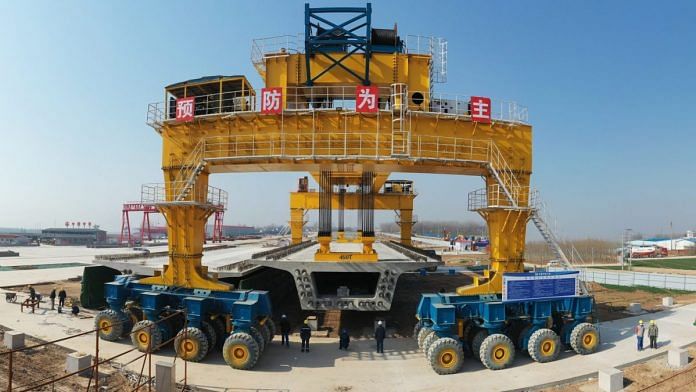Beijing: China is trying to build its way out of the coronavirus slump.
Economists expect local governments across the country to issue as much as 4 trillion yuan ($565 billion) in so-called special bonds this year, roughly twice last year’s total. The proceeds are to be spent on the same type of things that China splurged on following the global financial crisis more than a decade ago — roads, airports, and railways.
The plan is evident in the city of Heze in Shandong province, a relative backwater that’s nevertheless starting work on a connection to its first high-speed railway line.
While work paused for a few weeks amid the shutdowns, residents and officials there report that the framework of a modern bullet-train station is now rising above what were muddy fields just a few months ago.
“Construction has fully restarted and the scene is very lively and bustling these days,” said Zhang Fangzhen, a 44-year-old local entrepreneur whose house was torn down to make way for the station.
Work restarted at the construction site on Feb. 13, according to the Heze government, when the majority of China was still under lock down.
Fired on by Beijing, Heze and cities like it are pressing on with building projects of uncertain profitability with borrowed cash. The intention is that the bonds become self-financing, with project revenues sufficient to cover principal and interest over the life time of the debt.
“On the surface, debt repayments rely primarily on revenues generated by the projects themselves,” said Gloria Lu, senior director for the Asia Pacific Infrastructure Ratings team at S&P Global Ratings. In reality, “these are still government debts,” she said.
While governments around the world borrow record sums to fund stimulus aimed at curbing the impact of the coronavirus, China’s response has been modest by comparison. That’s partly due to officials’ painful experience grappling with the debts incurred following massive spending on infrastructure after 2008.
Still, China has already issued 1.29 trillion yuan worth of special bonds this year, with another 1 trillion yuan to be issued by the end of May, easily surpassing the 2.15 trillion yuan total last year. The majority of analysts surveyed by Bloomberg expect the government to sell between 3 trillion yuan and 4 trillion yuan in total.
“Among all the pro-growth measures, infrastructure investment is probably the only thing that the government can take the initiative to beef up and have control over,” Lu said.
China is expected to release this year’s budget, along with other key targets, at the annual legislative session of the National People’s Congress, which is set to kick off on May 22, according to the official Xinhua News Agency. Economists currently see the expansion slowing to below 2% this year.
In Heze, the prospectus for bonds financing the new station on the Rizhao-to-Lankao high-speed line — which will also include shops and parking lots — explains that repayment of the principal relies on land prices growing between 7.5% and 8.5% annually over the next 20 years. That’s about four times faster than average land prices are currently growing in the city.
Through a program supported by central bank cash, Heze is replacing old-style housing with modern high-rise blocks at the fastest rate anywhere in the country. Nevertheless, the area has seen net population outflows in the past few years as the younger generation leave for jobs in the provincial capital Jinan and elsewhere.
That “build-it-and-they-will-come” pitch is being replicated across the country. Government-led infrastructure is registering a faster recovery than the rest of the economy, China International Capital Corporation analyst Eva Yi wrote in a recent report.
“Recent policy announcements show a clear inclination toward levering the urban infrastructure upgrade as part of the efforts to stabilize aggregate demand growth,” she said.
Key infrastructure projects for 2020 include the build-out of the Sichuan-Tibet railway, a high-speed rail corridor along the Yangtze river and intercity connections in major city clusters. Elsewhere, special bonds are being used to fund toll-road projects from Gansu province in the north west to the rust-belt of Heilongjiang.
What Bloomberg’s Economists Say…
“Infrastructure investment remains the most effective approach for the government to support domestic demand and growth, after the economy registered a record contraction in 1Q. Given the concern about marginal return of infrastructure investment, a key for infrastructure investment is to allocate the funding to more productive regions, i.e., the metropolitan area in Pearl-River Delta and Yangtze-River Delta.” — Qian Wan (economist)
However, the quality and profitability of some projects is questionable.
“It’s common practice that local governments artificially inflate anticipated revenues of infrastructure projects in order to get approval to issue special bonds,” said Tang Fengchi, a consultant on public-private partnerships to China’s Ministry of Finance. “Special bonds can solve the funding problems, but it is no solution to local governments’ inability to make scientific decisions.”
Adding to the worrying situation are recent declines in tax and land sales revenues, which will put local governments’ debt servicing ability further into question. General public fiscal revenue contracted 14.3% in the first three months of 2020, and governmental fund revenue fell 12% in the first quarter, with land-sale revenue down 7.9%.
Shandong province is selling bonds for the Heze rail project in two tranches: 2.7 billion yuan in July 2019 and 2.3 billion yuan to be sold in June 2020. It estimates that every 100 million yuan invested will ultimately generate 210 million yuan to regional gross domestic product.
From today’s perspective, it isn’t obvious that Heze is heading for that kind of outcome.
“Heze is really economically backward,” said Mr. Zhang. “Most local people leave the city for construction job opportunities elsewhere.” –Bloomberg
Also read: Incentives and infrastructure — what govt can do to boost data centres in India






